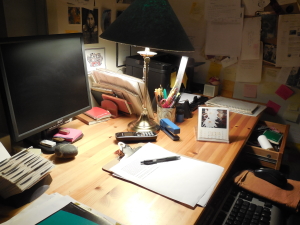More on Self-Editing
No matter your level of experience, the first draft of a writing project, whether it’s a blog post or a book length manuscript, will need revisions—if not a major overhaul. This is an expansion of ideas presented in an earlier post: http://thescribes.ca/feedback-on-your-family-history-or-memoir-draft-is-helpful/
Here’s a typical self-editing process:
 • Set the manuscript aside for a few weeks to clear your mind and gain objectivity.
• Set the manuscript aside for a few weeks to clear your mind and gain objectivity.
• Reread it on screen and make adjustments as you go. If you get stuck or stalled, highlight that trouble spot and move on. Maybe there’s a piece that needs more research? Highlight that too and continue.
• With that full revision done, your manuscript is becoming more cohesive—but it probably still needs lots of work. Many writers enjoy the creative process of this phase. You’re working with the whole piece, polishing and embellishing.
• You may find it useful to take another break from the manuscript before you give it at least one more full revision on screen. Pose some questions of this draft: Is the theme clear now? (That’s the question that lies at the heart of this narrative.) Is that theme illustrated with clarity and intrigue throughout? If the subject has allowed me a cast of characters, have I presented their needs, goals and foils? Is the pace and storytelling compelling, or does it drag in spots? Have I confused and muddled things with too many characters (often a problem in the community histories I write). Can I liven up an important section with a scene or half-scene? Are there more words than needed? Does the ending satisfy and draw everything together?
• With two or more on screen edits complete you may be ready to take a section—something you think needs work but you’re not sure what—to a writers’ group. (More on getting feedback from peers coming soon in a blog post from Annette.)
• Print the manuscript and edit it on paper. The paper version facilitates close reading, which working with a distant, glowing screen does not. You may find areas that still need major rewrites. Mark the latter and do that work later on screen.
• With all those changes entered, it’s time to read the manuscript (or parts of it) aloud to someone—or even to yourself. Reading aloud forces you to see every word (we all skim read and this is especially so on a computer screen). You’ll hear the rhythm and cadence of your prose and you’ll assume someone else’s perspective. This is one of the best self-editing tools!
• With more revisions complete, print and reread the draft again (aloud or silently). Why print it yet again? You need an attentive review here because you’re getting close to completion. It can work well at this stage to read a bit on paper and enter changes directly on the computer screen, in tandem. I prefer this to the tedium of the search to find each line and word in page after page later.
• Now you’re ready for a full manuscript review by a first reader—a writer, if possible, to get more insightful feedback. You may hear things that take you by surprise, both good and challenging. Evaluate this reader’s response with an open mind and a willingness to make yet more changes.
• For a newer writer, it may be wise to put the manuscript aside again for a few months to clear your mind of it. When you return you’ll be better able to assess its strengths and weaknesses.
Do you have some methods or a process you follow to add here? Send us an e-mail. We’ll be writing more on this subject later.
Responses:
Hi Jeanette … saw your post on self-editing today. Many of your suggestions would work well for fiction and I thought you might be interested in some feedback from that perspective.
Hope your writing is going well,
